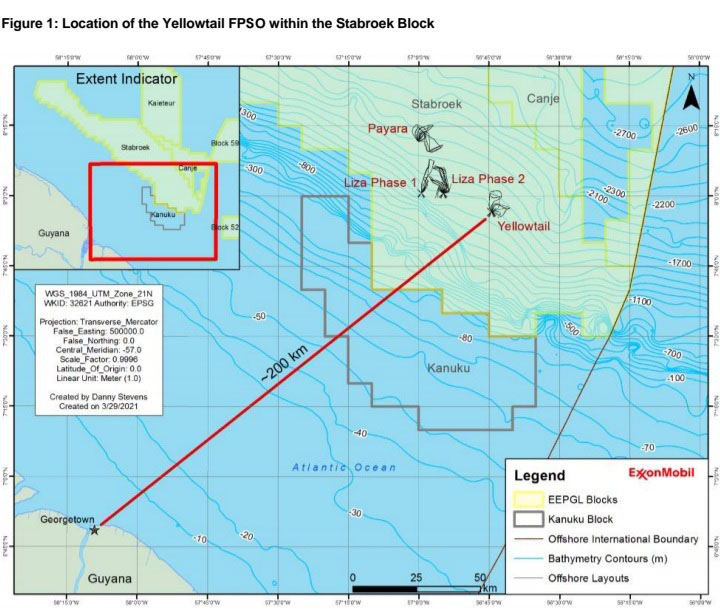ExxonMobil subsidiary, Esso Exploration and Production Guyana Limited (EEPGL) has applied for an Environmental Authorization to undertake the Yellowtail Development Project – what would be the fourth oil extraction well offshore Guyana.
According to its project summary, the site will be located in the eastern portion of the Stabroek Block, 200 km from Georgetown. Oil production from Yellowtail Development Project is expected to last at least 20 years with approximately 45-55 wells to be drilled offshore to support extraction.
The Environmental Protection Agency (EPA) in a notice said that it had determined that an Environmental Impact Assessment (EIA) will have to be conducted before a decision to approve or reject the proposed project is made as it may significantly impact the environment. Members of the public are invited to make written submissions to the Agency outlining questions and matters which they need to be answered or considered in the EIA. This should be done within the next 28 days.
EEPGL is the designated Operator of the Stabroek Block under a Petroleum Agreement signed by EEPGL and its co-venturers, Hess Guyana Exploration Limited and CNOOC Petroleum Guyana Limited, with the Government of Guyana.
The Yellowtail Development Project will be the fourth deep water petroleum development project in Guyana. EEPGL already has approval from the Government for three development projects in the Stabroek Block: Liza Phase 1, Liza Phase 2 and Payara.
The project summary which can be found on the EPA’s website, said that the proposed project will develop the Yellowtail and Redtail fields, and other resources if such is determined to be feasible and competitive. It was stated that Yellowtail will be designed to add up to 250,000 barrels of oil per day (bpd) to existing daily production volumes in Guyana. EEPGL said that during the early stage of production operations, the FPSO is anticipated to produce up to an average of approximately 6,600,000 – 7,500,000 barrels of crude oil per month. However, these estimates are preliminary and are subject to change.
The Yellowtail Project will involve drilling of production wells; installation, commissioning and operations of Subsurface Umblicals, Risers and Flowlines (SURF); a Floating Production and Storage Offloading vessel (FPSO); and handling and offloading of produced hydrocarbons. The Project will utilize marine support vessels as well as onshore infrastructure, including but not limited to shore bases, warehouses, storage and pipe yards, fabrication facilities, fuel supply facilities, and waste management facilities in Guyana. These types of infrastructure will be used to support the drilling, installation, production operations, and decommissioning stages of Yellowtail.
Approximately 1,200 personnel will be employed offshore during the stage where the wells are being drilled and the offshore oil production facilities are being installed. This number will decrease to less than 200 personnel during the production operations phase. A smaller number of personnel will be utilized at the onshore support facilities.
Gas flaring
EEPGL noted that the Liza Destiny FPSO experienced some unanticipated technical difficulties and unplanned gas flaring during its start-up and commissioning processes in 2020 and assured that they have conducted comprehensive root cause analysis and evaluated potential improvements to gas handling systems so steps will be taken to incorporate lessons learned into future projects, including yellowtail.
Regarding flaring, EEPGL said that this will only occur under very unique operational circumstances and that the FPSO will use treated sea water for cooling and injection into the reservoir for additional pressure maintenance and assured that the water will be discharged overboard with the industry’s best practices.
The project summary stated that once approved, production is expected to begin in 2025. The FPSO will be capable of storing approximately 2 million barrels of oil. The FPSO will have living quarters and utilities needed to support operations personnel on the FPSO.
For its decommissioning stage, EEPGL said that a programme for Yellowtail will be submitted to the Government for approval and that the final decommissioning strategy is expected to include a comparative assessment which will address all potential safety, environmental, technical and economic impacts. EEPGL would decommission the offshore production facilities in accordance with the abandonment plan approved by the government.
Air quality and climate, ecological balance and ecosystems, sound, cultural heritage, marine geology and sediments, community health and wellbeing, marine water quality, employment and livelihoods, coastal habitats, marine use and transportation, coastal wildlife, social infrastructure and services, protected areas and special status species, land use, seabirds, ecosystem services, marine mammals, riverine mammals, Indigenous people and traditional use of resources and land, marine turtles, economy/economic conditions, marine fish, waste management infrastructure capacity and marine benthos can be potentially impacted directly or indirectly by the project.

